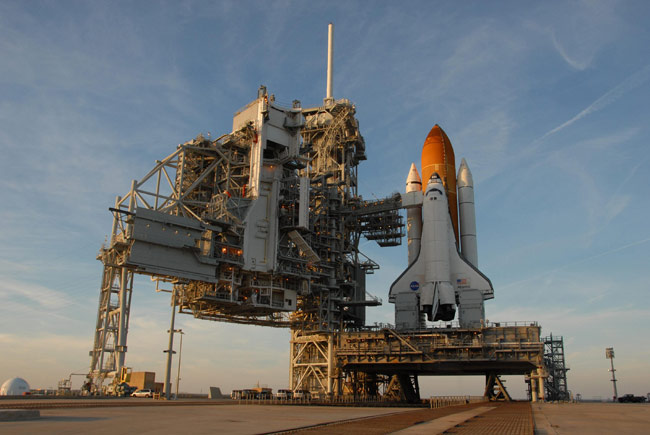NASA: Space Shuttle on Track for Thursday Launch

CAPECANAVERAL, Fla. ? NASA's space shuttle Atlantis is ready for a Thursday space shotattempt, mission managers said today.
Atlantis isslated to launch the seven-astronaut crew of the STS-122 mission into space fromKennedy Space Center (KSC) on Thursday. Doug Lyons, launch director forthe mission, said he's hopeful for an attempt at 2:45 p.m. EST (1945 GMT) ? fickle Florida coast weather permitting,of course.
"We'reall thinking that Thursday's the day, regardless of what the weather guy mighttell you," Lyons said. "We'reready to make [the launch] happen."
LeRoy Cain,chair of NASA's mission management team here at KSC, said he's confident problems are nowresolved with two fuel gauge-like sensors in the bottom of the shuttle's 15-story external fuel tank aswell as a kinked radiator hose in the payload bay of Atlantis. Engineers tracked the sensor glitch to a bad electrical connector and replaced it.
"We'renot working any issues," Cain said. "We're hoping it will stay thatway, of course, and we have some confidence that it will."
Casesclosed
Lyons said technicians will constantly testthe fuel gauge sensors, known as engine cutoff (ECO)sensors, during fueling of the external fuel tank early Thursday morning.
Breaking space news, the latest updates on rocket launches, skywatching events and more!
"We'llbe keeping a close eye on our ECO sensors," Lyons said, noting that launchshould commence even if one of the four devices fails during testing.
The sensorsare designed to stop the three main engines of Atlantis before its 500,000 gallons(1.9 million liters) of fuel runs dry. Because the cryogenic fuel runs through theorbiter's engine cones and cools them as it is expelled and burned, running outof fuel could cause catastrophic damage to the spacecraft, mission managers have said.
Cain said Atlantis' kinkedhose is now tucked back into it's intended place, but engineers are stilldetermining whether or not it could leak after the payload bay doors are openedand again closed ? a maneuver that could again cause it to bend outwards in astressed position.
"We'rea long ways from having a leak develop in this particular hose we have onAtlantis," Cain said. But in the unlikely event of a leak, he explained,the orbiter's computers would shut down the redundant radiator system beforeFreon could leak out.
Anxiousfor orbit
Navycaptain Stephen Frick will head the 11-day mission, the prime objective ofwhich is to deliver the European Space Agency's (ESA) bus-sized Columbuslaboratory to the International Space Station (ISS).
AlanThirkettle, space station program manager for the ESA, said he's pleased withthe work done by NASA to get Atlantis into orbit.
"Froman ESA point of view that we're very confident and very comfortable with thedesign fixes ? since December," Thirkettle said. "It seems very, verysolid."
As missionmanagers wait to see if the weather will shape up for a safe launch onThursday, Lyons said the astronauts are waiting in good spirits.
"They'revery anxious to get to launch day, get in orbit, and start their mission," Lyons said.
NASAwill broadcast Atlantis' STS-122 mission live on NASA TV. Click here for SPACE.com'sSTS-122 mission coverage and NASA TV feed.
- SPACE.com Video Interplayer: NASA's STS-122: Columbus Sets Sail for ISS
- The Great Space Quiz: Space Shuttle Countdown
- VIDEO: ISS Commander Peggy Whitson Takes Charge
Dave Mosher is currently a public relations executive at AST SpaceMobile, which aims to bring mobile broadband internet access to the half of humanity that currently lacks it. Before joining AST SpaceMobile, he was a senior correspondent at Insider and the online director at Popular Science. He has written for several news outlets in addition to Live Science and Space.com, including: Wired.com, National Geographic News, Scientific American, Simons Foundation and Discover Magazine.
